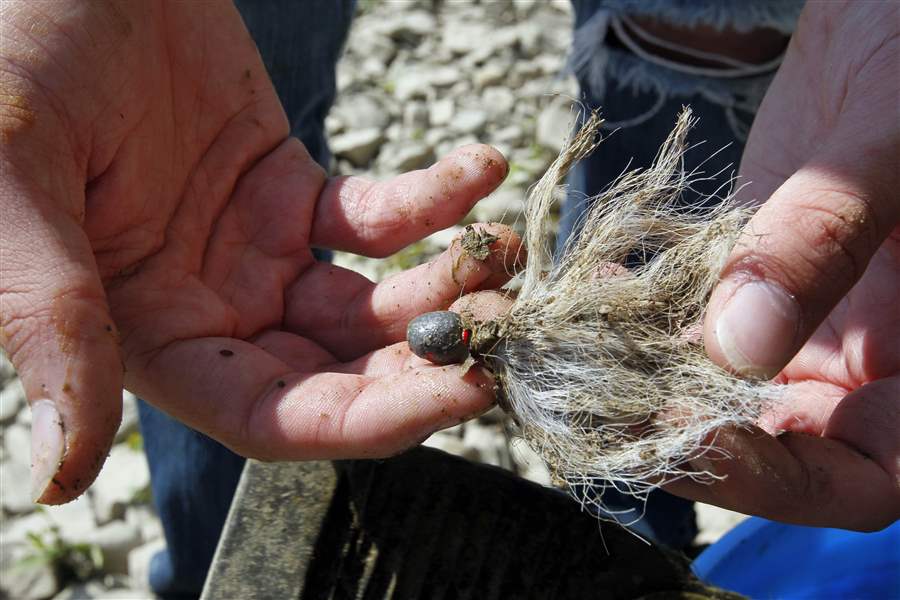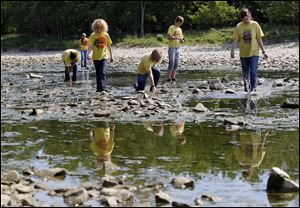
COMMENTARY
Get the lead out
Teens energize effort to clean up Maumee River
6/10/2012
Old lures made of lead are removed from the Maumee River. The toxic lead is dangerous to fish and other wildlife.
The Blade/Amy E. Voigt
Buy This Image

Volunteers from the Toledo ZooTeens, in conjuction with Partners for Clean Streams, search the Maumee River to remove fishing lures made of lead.
This clearly isn't the food court at the mall, the movie theater or the ice cream shop down on the corner. This is not the place you would expect to find a group of teens on a sunny summer Sunday.
Lianna Franklin, a 15-year-old who will be a sophomore at Anthony Wayne in the fall, is shin-deep in muddy water, with both hands submerged in a gooey concoction of jelly-like algae, leaves, and other debris.
She picks up trash from the shallow arm of the Maumee River that bends around Blue Grass Island at Side Cut Metropark, but what she is really after is heavy metal -- lead.
"The lead is really harmful," Franklin said, "so it is important we get all of it out of the river. I don't want the fish to get poisoned.
The lead is present in the form of fishing lures, lodged between the rocks in the river bottom. The lures became snagged during the spring spawning run when hundreds of walleye fishermen were working the waterway, and thousands of the lead-headed jigs or weights likely dot the floor of the Maumee in the prime fishing area, which runs from the rapids area upriver from the I-475 bridge down to the boat launch in Orleans Park in Perrysburg.

Old lures made of lead are removed from the Maumee River. The toxic lead is dangerous to fish and other wildlife.
As summer approaches and the water level drops, more and more river bottom is exposed. With keen eyes and limber backs, the ZooTeens corps, that Franklin is a part of, make up an ideal search-and-retrieve team to clean up the river.
"We try and educate them first -- tell them just why we are doing this -- and then let their enthusiasm and energy drive the effort," said Ava Slotnick, outreach coordinator for Partners for Clean Streams, a conservation focused non-profit based in Perrysburg.
This is the eighth year for the organization's "Get the Lead Out" program, which enlists a variety of volunteer groups to help with the effort to clear as much lead and fishing line from the river as possible.
Lead is toxic when ingested and some of the sinkers or split shot weights can be mistaken for food by water birds or fish. The broken strands of line can entangle fish or other wildlife.
"When they're left in the river, the lead and the line are both bad for the fish and other wildlife," said Chris Toy, who will be a sophomore at St. Francis in the fall. "Lead is really dangerous and has an effect on everything in the ecosystem, and the old fishing line can catch on anything, so it helps all of the organisms if we get these things out of the river."
On a recent morning, the group of 11 teens from 13 to 16 years of age started their date with the river rather gingerly, but soon they were scattered across a wide stretch of the waterway. Five-gallon buckets served as the collection vessels for the lead and line, with plastic bags quickly filling with trash and litter gathered from the banks.
The old lead is sorted from the rest of the flotsam and jetsam left behind after the spring runs on the river, and sold to an area lure manufacturer to be re-used. The strands of fishing line the group gathered will end up being recycled into a variety of lightweight products. The rest of the debris is recycled whenever possible.
"It's kind of sad to see the way people treat the river, with trash just thrown around," said Franklin, who hopes to be a marine biologists one day.
"It's a beautiful place, if we just take care of it."
Franklin got introduced to the Maumee at a younger age when she accompanied her dad while he was fishing the river. For many of the other ZooTeens, this lead scavenger hunt marked their first foray into the mighty stream. The Maumee runs some 130 miles from its start in a swamp near Fort Wayne to Lake Erie, and has the largest drainage area of any river system in the Great Lakes.
"I guess at first, it was just another river," Franklin said. "But once you learn about it and see it so close like this, it really starts to matter to you."
Previous river cleanups sponsored by Partners for Clean Streams have been assisted by volunteers from Trout Unlimited, various area Rotary Clubs, the Boy Scouts, Fort Meigs Sertoma Club, and the family members and friends of the Partners organization.
Slotnick said that while the adult volunteers might be a little less excited about the opportunity to splash around in the river, they are just as serious about keeping the river clean.
The ZooTeens she had in the water on a recent Sunday morning started out with a playful approach to tending to the river's ecosystem, but quickly became passionate about the cause.
"They help a lot with covering a big area and removing a lot of dangerous material, but as a bonus, they are also getting out there and experiencing the river and all that is involved with it," Slotnick said. "I think they develop an appreciation for what the river can be."
Contact Blade outdoors editor Matt Markey at: mmarkey@theblade.com or 419-724-6068.